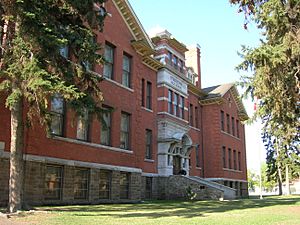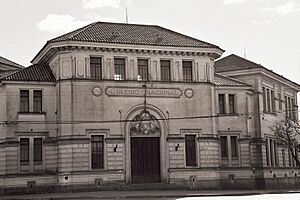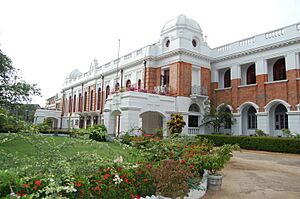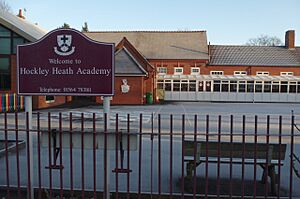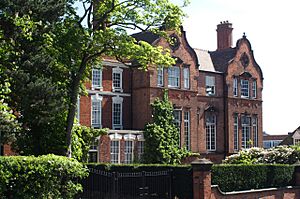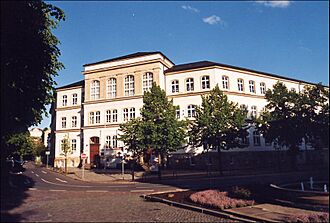State school facts for kids
A state school, also known as a public school or government school, is a school that teaches all students for free. These schools get their money from taxes and are run by the government. State-funded education is common around the world, from primary school (ages 4-5) up to secondary school (around age 18). Other ways to learn include homeschooling or attending private schools.
Contents
- How Schools Work Around the World
- Schools in Africa
- Schools in the Americas
- Schools in Asia
- Schools in Europe
- Denmark's Tax-Funded System
- England's State-Funded Schools
- France's Centralized System
- Germany's State-Controlled Education
- Ireland's Publicly Funded Schools
- Italy's Long History of Universities
- The Netherlands' Equal Funding
- Romania's Publicly Funded Schools
- Russia's State-Regulated Education
- Scotland's Public Schools
- Spain's Compulsory and Free Education
- Sweden's Tax-Funded Schools
- Schools in Oceania
- See also
How Schools Work Around the World
Different countries have different ways of running their state schools. Let's explore some examples!
Schools in Africa
South Africa's Public Schools
In South Africa, state schools are officially called public schools, even though people don't often use that term. These schools are owned by the government. There are also "independent schools," which are private. Some private schools that don't charge high fees get some money from the government.
Schools in the Americas
Canada's Provincial Education
In Canada, each province is in charge of its own public school system. This means things can be a bit different from one province to another.
Most provinces offer kindergarten. From about age six (Grade 1) up to Grade 12, education is free and funded by the government. Schools are usually split into elementary schools (kindergarten to Grade 8) and high schools (Grades 9 to 12). Some areas also have middle schools.
Students must attend school until age sixteen in most provinces. In Ontario and New Brunswick, they must attend until age eighteen. Some Canadian provinces also have government-funded religious schools, like Catholic schools in Ontario.
Latin America's Free Education
In countries like Brazil and Mexico, public schools are run by the government and don't charge tuition. These schools exist for all ages, from early childhood to university. Mexico offers nine years of free and required primary and secondary education.
Panama has eleven years of required education, starting from pre-kindergarten. Parents are legally required to help their children financially until age 25 if they are still studying.
In Argentina, education is a shared responsibility between the national government, provinces, and private schools. Education has always been free, even at universities.
United States Public Schools
In the United States, "public school" usually means elementary, middle, or high schools that are funded by local or state governments. "Private school" means schools not owned by the government. Schools run by religious groups are often called parochial schools.
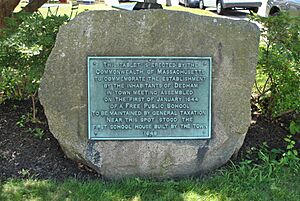
The U.S. federal government has a limited role in education. States have direct control over their schools. The United States Department of Education oversees the federal government's role. State and local governments regulate public, private, and religious schools.
Public schools are mainly funded by local taxpayers. Local school boards, which are usually elected, set policies for schools in their area. The first free public school in America was the Syms-Eaton Academy in Hampton, Virginia, founded in 1634. The first tax-supported public school was in Dedham, Massachusetts.
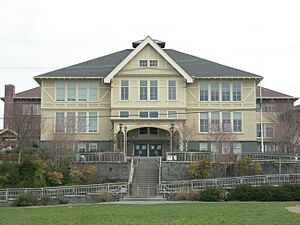
Most students in the U.S. attend public schools (88%). Public school is typically divided into three parts:
- Elementary school (kindergarten to 5th or 6th grade)
- Middle school (5th, 6th, or 7th grade to 8th or 9th grade)
- High school (9th or 10th to 12th grade)
Some schools combine these levels, like K-8 schools where students attend only two schools for their entire K-12 education. Public universities in the U.S. are also called "public." They usually charge tuition, but it's often much lower than private universities, especially for students who live in that state.
Schools in Asia
Bangladesh's Government High Schools
In Bangladesh, government-funded schools are called 'Government High School'. They teach students from Year 1 to 10. All public schools follow the National Board Curriculum. While many children in rural areas might leave school after Year 5, this is less common in big cities like Dhaka. Many good public schools have an entrance exam. Lessons in public schools are taught in Bengali.
China's State-Funded Schools
In China, state schools are funded and run by the government. Some high schools charge extra fees, even though they are state schools. Top state schools are very selective. Historically, public spending on schools in China was uneven, favoring urban schools. There was also a system of "key schools" that received more funding to develop top-level education. This "key school" system was changed in 2006 to help make education more equal.
Hong Kong's Government Schools
In Hong Kong, "government schools" are free schools funded by the government. There are also "subsidised schools," which are the most common and often run by religious groups.
India's Public Education
During British rule, some state universities were set up in India, but not much was done for primary and secondary schools. Today, about 80% of all Indian schools are government schools, making the government the main provider of education. However, many children (27%) attend private schools because of concerns about the quality of public education. Education in India is funded by federal, state, and local governments, as well as private groups.
Indonesia's Compulsory Education
Education in Indonesia is overseen by two government ministries. There is a 12-year compulsory education program. The system has three stages: primary, secondary, and tertiary (higher education).
Japan's Public Schools
Most students in Japan attend public schools through junior high. However, private education is popular for high school and university.
South Korea's National System
South Korea has a long history of public education, with systems in place since the Koryo Dynasty. Today, education in public schools (Grades 1–12) is required, except for kindergarten. The Ministry of Education is responsible for all public education, including funding and curriculum. South Korea is known for its high education standards.
Malaysia's Federal Education
In Malaysia, education is overseen by two government ministries. Education is the responsibility of the federal government, but each state has an Education Department. Primary education is required by law. Like other Asian countries, standardised tests are common.
Philippines' Oldest Public System
The Philippines has had a public education system since 1863, making it the oldest in Asia. It was created during the Spanish colonization. Modern public schools are run by the Department of Education.
Sri Lanka's Free Education
Most schools in Sri Lanka are maintained by the government as part of the free education system. There are three types of government schools:
- National Schools: Controlled directly by the Ministry of Education.
- Provincial Schools: The majority of schools, funded and controlled by local governments.
- Piriven: Monastic colleges for Buddhist priests, also funded by the Ministry of Education. These were historically centers of learning for everyone.
Schools in Europe
Denmark's Tax-Funded System
The Danish school system is supported by taxes. There are no tuition fees for regular students in public schools and universities. The public primary schools, called folkeskoler (meaning 'people's schools' or 'public schools'), cover all required education from age 6 to 17. Parents can also send their children to private schools, which receive some government funding but can also charge fees.
England's State-Funded Schools
England has a strong state-funded school system. There are many types of state-funded schools, including academy schools, community schools, and faith schools. About one-third of English state-funded schools are faith schools, often linked to the Church of England or the Roman Catholic Church.
All state-funded schools must follow the National Curriculum for England, which includes twelve subjects. This curriculum aims to help students grow in many ways and prepare them for life.
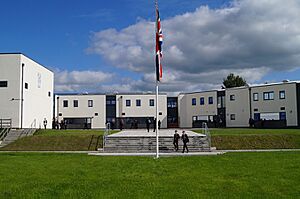
Many state-funded secondary schools are specialist schools, getting extra money to focus on certain subjects. Schools can ask parents for voluntary payments for extra activities like swimming lessons.
Comprehensive schools are secondary schools (ages 11–18) that accept all students, regardless of their academic ability. About 90% of English secondary students attend comprehensive schools. They offer a wide range of subjects, including practical and vocational learning.
Grammar schools select students based on their academic ability, often through an eleven plus exam. The oldest state school in England is Beverley Grammar School, founded in 700 AD.
France's Centralized System

The French education system is very organized and controlled by the government. It has three stages:
- Primary education (kindergarten and elementary school)
- Secondary education (collège and lycée)
- Higher education (university)
Schooling is required from age three. Primary education starts in kindergarten (école maternelle) for children aged 3 to 6, and then école élémentaire from 6 to 11. Teachers in public schools are government employees.
French secondary education is divided into:
- The collège for the first four years after primary school.
- The lycée for the next three years.
Finishing secondary school leads to the baccalauréat (or bac) diploma. This exam helps students get into university or start a career. The baccalauréat général has three main study paths: science, economics and social sciences, and languages and philosophy.
Germany's State-Controlled Education
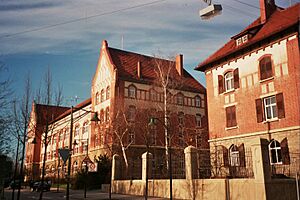
Education in Germany is mostly provided by the government, with states (Länder) controlling the curriculum and policies. Public schools do not charge tuition fees.
The first stage is Grundschule (primary school), from 1st to 4th or 6th grade. After primary school, at age 10 or 12, students have four main secondary school options:
- Hauptschule: The least academic, usually until 9th or 10th grade.
- Realschule: Until 10th grade, leading to a specific certificate.
- Gymnasium: High school until 12th or 13th grade, with the Abitur exam for university entry.
- Gesamtschule: A comprehensive school offering all the options above.
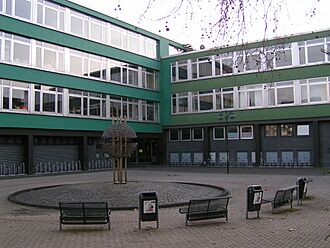
Students who finish Hauptschule or Realschule often continue at a vocational school (Berufsschule) to gain job qualifications. Most universities in Germany are also public and subsidized by the states, meaning tuition fees are usually low.
Ireland's Publicly Funded Schools
In the Republic of Ireland, most secondary schools are publicly funded and regulated by the state, but they are privately owned and managed. Many are run by religious organizations, mainly the Catholic Church. These schools receive money from the state. Some charge fees, while others do not. All state-funded schools teach the national curriculum. Students take the Junior Certificate exam after three years. After that, most students take the Leaving Certificate, which can lead to higher education.
Italy's Long History of Universities
Italy has had a state school system since 1859. It also has a long history of universities; the University of Bologna, founded in 1088, is the oldest university in the world. The Italian school system has three levels:
- Primary education (nursery and elementary school)
- Secondary education (first grade 11–14, second grade 14–19)
- Higher education (university 19+)
Public schools in Italy are completely free for compulsory schooling (until age 16). For the last two years of high school, students pay a small tax. Public universities are free for lower-income students, with fees increasing based on income. In Italy, public schools are generally seen as providing a better education than private schools.
The Netherlands' Equal Funding
In The Netherlands, public, special (religious), and general-special (neutral) schools all receive equal financial support from the government if they meet certain rules. While officially free, these schools might ask for a small contribution from parents. Private schools, which rely on their own money, are very rare.
Romania's Publicly Funded Schools
All schools up to high school in Romania are publicly funded and regulated by the Ministry of National Education. Universities can also be state-sponsored for some students. While private schools exist, they are not as popular because the quality of education in public schools is generally just as good.
Russia's State-Regulated Education
Education in Russia is mainly provided by the state and regulated by the Ministry of Education and Science. Regional authorities also oversee education in their areas.
Scotland's Public Schools
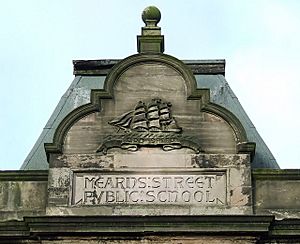
In Scotland, a "public school" means a state-controlled school run by the local education authority. These schools generally don't charge fees and are supported by local and national taxes. The Church of Scotland started providing schools in every parish in 1560, with free education for the poor. In 1633, the Parliament of Scotland introduced local taxes to help fund these schools. Schooling wasn't entirely free, but tax support kept fees low. In 1872, education became required for all children aged 5 to 13, with "public schools" (meaning schools for everyone) run by local school boards. School fees ended in 1890. Children in Scottish state schools usually start primary school between four and a half and five and a half years old. They stay for seven years (Primary One to Seven). Then, at age eleven or twelve, students start secondary school for a required four years, with an optional two more years. Students take National 4 & 5 exams around age fifteen or sixteen. These include required exams in English, mathematics, a foreign language, a science subject, and a social subject. The minimum school leaving age is sixteen.
Spain's Compulsory and Free Education
In Spain, Primary Education and Compulsory Secondary Education make up Basic Education. These stages are required and free for everyone, usually from ages 5 to 16. After this, students can choose to study for the Bachillerato (similar to A-levels) to get into university, or go for Professional Training. Education in Spain is a universal right and duty, guaranteed for 100% of the population up to age 16.
Sweden's Tax-Funded Schools
In Sweden, state schools are funded by tax money. This includes primary schools (grundskola), secondary schools (gymnasium), and universities. Private schools also receive government funding but cannot charge tuition fees. Required education starts at six years old in pre-school (förskola). Swedish primary school is divided into three parts:
- Lågstadiet (grades 1-3): Students learn basics in Swedish, English, and mathematics.
- Mellanstadiet (grades 4-6): More detailed subjects are introduced, including a second foreign language.
- Högstadiet (grades 7-9): Studies become more in-depth.
Swedish children take national exams in grades 3, 6, and 9. They start receiving grades in grade 6, using a letter-based system from A to F.
Schools in Oceania
Australia's Government Schools
In Australia, government schools, also called public or state schools, are free for Australian citizens and permanent residents. Private schools charge fees. Government schools can be "open" (accepting all students from their area) or "selective" (admitting students based on specific criteria like academic merit). As of 2022, Australia has a high number of students in private schools (over 30% in primary, over 40% in secondary). All schools, whether government or private, must follow the same curriculum frameworks for their state or territory. Most students wear uniforms.
New Zealand's State-Funded Education
In New Zealand, both state and state-integrated schools are funded by the government. State-integrated schools are former private schools that have joined the state system while keeping their special character. About 86% of school-aged children attend state schools. Education is free up to the end of the calendar year following a student's 19th birthday. Primary and secondary education is required for students between ages 6 and 16, though most children start school at age 5. Primary education usually ends at Year 8, and secondary education at Year 13.
See also
 In Spanish: Escuela estatal para niños
In Spanish: Escuela estatal para niños
- Education Index
- Free education
- Public university


